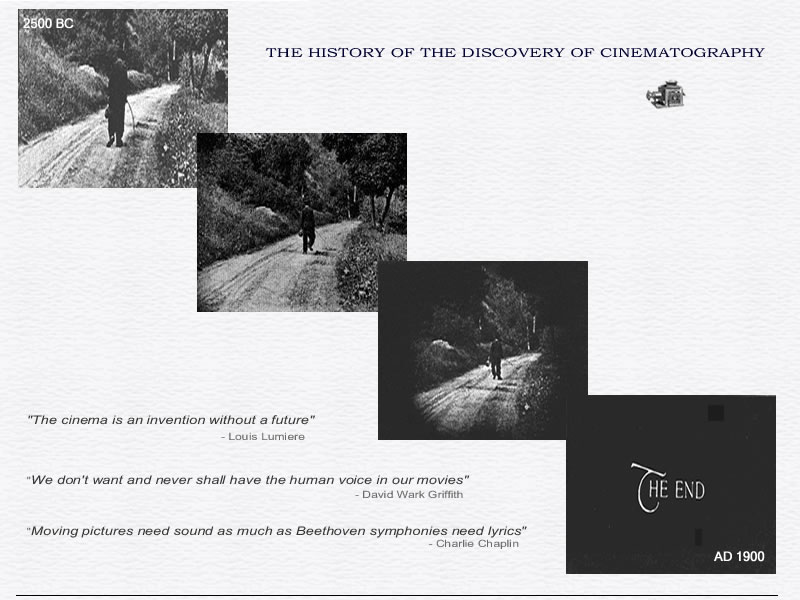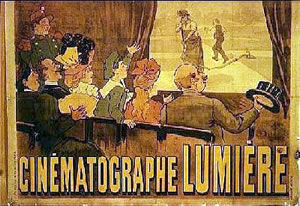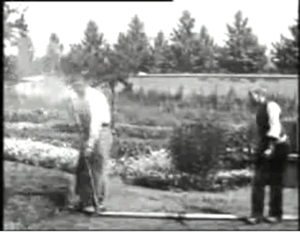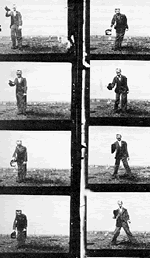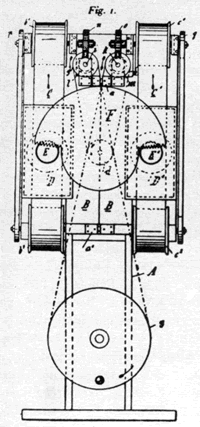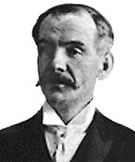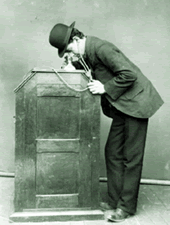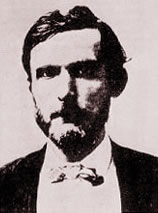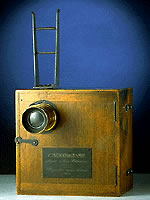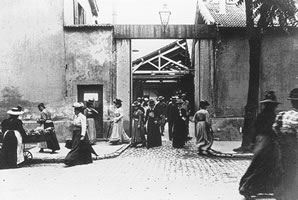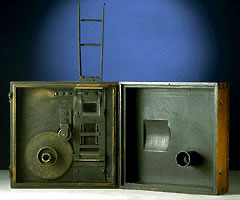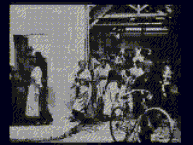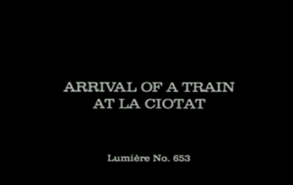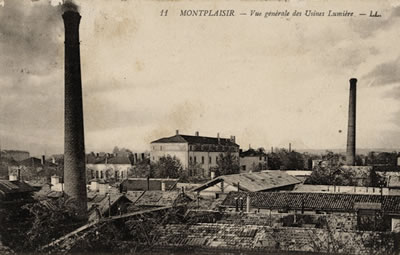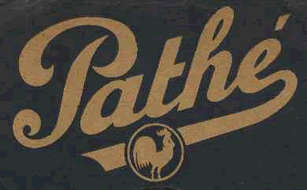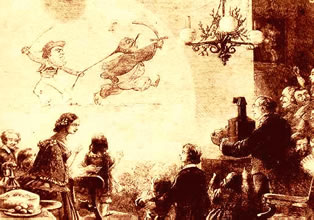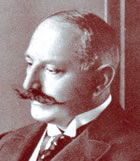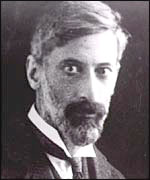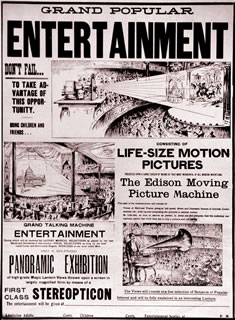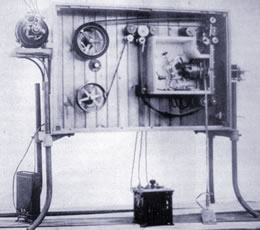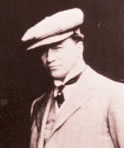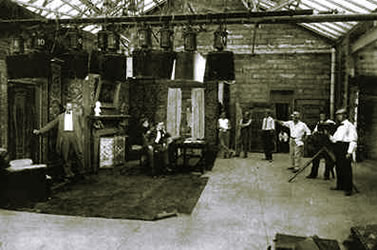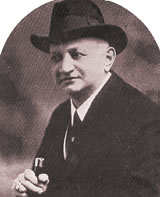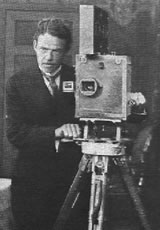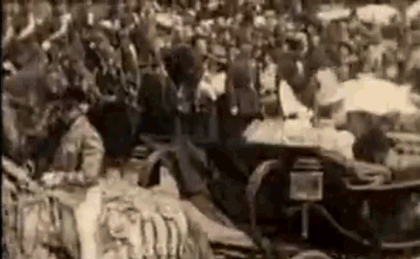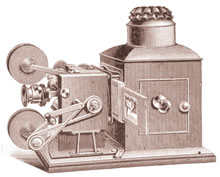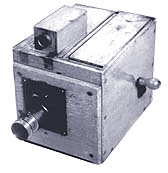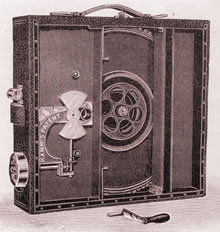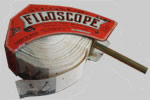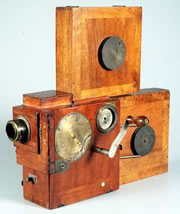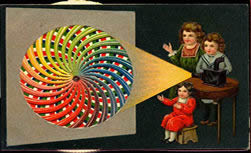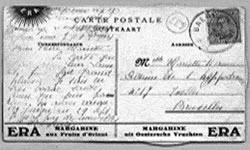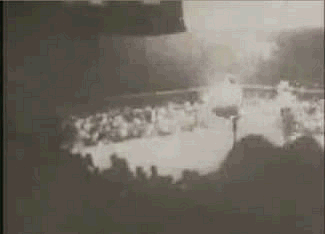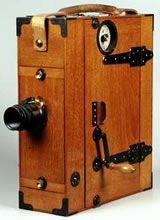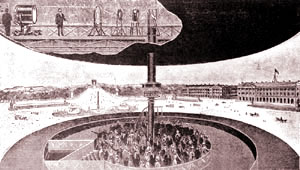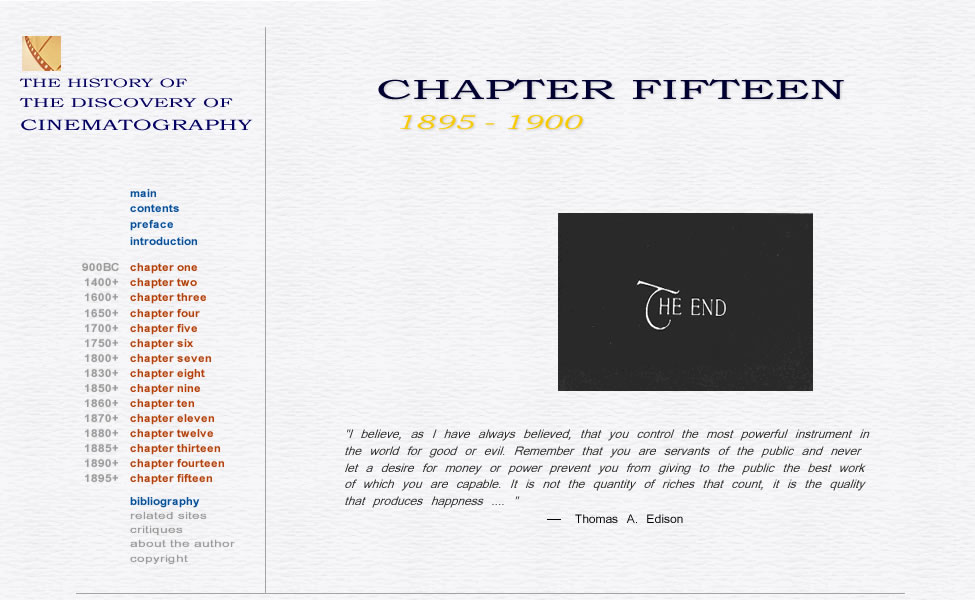 |
|
|
| |
1895
AUGUSTE (1862 - 1954) LOUIS (1864 - 1948) LUMIERE
Before their public
presentation in December this year to paying customers, the
Lumière's filmed a comedic scenario called 'L’Arroseur
arrosé' (The Waterer Watered).
In it was the Lumière
gardener François Clerc, along with a boy apprentice
working in the Lumière labs, Benoît Duval. The
story was of course simple and along the more modern lines of
'Denise the Menace'.
An image from the film
was used in the background of a poster promoting Lumière
films and their Cinématographe.
The poster (right)
depicts gardener Clerc and apprentice Duval on the screen in
the background. |
|
| |
Cinématographe Lumière
Poster from 1895 (above)
|
|
|
| |
|
|
| |
|
|
| |
Also promoted as 'The
Sprinkler Sprinkled', 'Le Jardinier', 'Le Jardinier et
le petit espiègle', and 'The Tables Turned on
the Gardener' in English, this short film (under one minute)
has been called the first true "scenario" designed to portray
comedy on film however this claim is difficult to make. |
|
| |
|
|
|
| |
|
|
|
| |
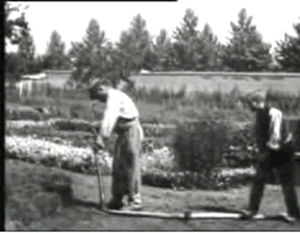 |
|
| Eleven
seconds of footage from 'L’Arroseur arrosé'
(above) |
The frame from which the artist
used to create the poster (above)
|
| |
|
|
|
| |
The film runs a little under 49 seconds and whether the first of it's
kind or not, it is a step beyond that of the Lumière's
Actualités which were still being made by the Lumière's
and their associates. The artist (Marcellin Auzolle) took one frame
to use in his rendering for the movie screen the patrons are watching
in laughter - that of Duval taking his foot off the hose and the water
spraying up into Clerc's face. The poster is the first known to promote
an individual film because of its use of the background screen image,
however the image we have today of this poster (above right)
is cropped and likely not the full original poster created.
Notice the lower borders of the poster's frame are visible but the
upper border is not seen. We suggest the actual poster was at least
twice as high as this cropped image. The artist has placed his name
vertically at the bottom right corner although it is not readable. This
cropped image promotes only the Cinématographe
Lumière and not the film by name. However we do believe
the original poster (now lost) promoted the film in more detail. |
|
| |
|
|
|
| |
|
|
|
| |
COPY CAT FILMS
& REMAKES
Soon after film pioneers had
learned new ways to entertain their fledgling audiences with scenarios
like the one above, we find them producing remakes and 'other versions'
of their own films. Short films that had shown modest success. The ability
of Lumière to draw an audience to see a gardener get soaked by
his own hose was not lost on other filmmakers.
Nor were Auguste and Louis
immune to repeating something that worked. They alone re-made 'L’Arroseur
arrosé at least two other times. We can also include
G.A. Smith, Edison, Méliès and A. G. Blache among others
who had made their own versions of this very film. It was even made
as late as 1900 and named "The Biter Bit".
|
|
| |
|
|
|
| |
|
|
|
| |
|
|
| |
|
|
|
| |
|
|
|
| |
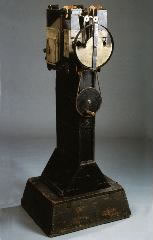 |
1895
MAXIMILLIAN SKLADANOWSKY (1863 - 1939)
Approximately
27 days (November 21, 1895) before the Lumiere screening
in Paris (December 28, 1895), Skladanowsky unveils his Bioscop
(also Bioskop) at the Wintergarten Hall
in Berlin and screens as few as eight short films totaling about
fifteen minutes. His paying customers watched as two separate filmstrips
projected at a rate of 16 frames per second. Skladanowsky's Bioscop
was never to be a viable piece of machinery because of its cumbersomeness.
These
frames (right) from Skladanowsky's Bioscop
camera/projector were from a presentation given on November 21,
1895 at the Wintergarten Hall in Berlin. They show a burlesque performer
doing the old 'watch me drop me hat and it will come back to me'
trick. The Bioscop could not compete with what
was coming out of England, France and the US and would eventually
be forgotten by time. The Bioscop (left). |
|
|
|
| |
|
|
|
| |
|
|
|
| |
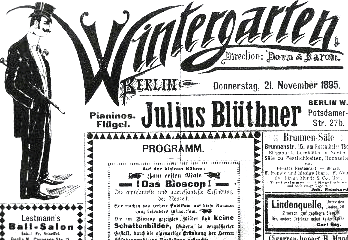 |
|
This poster
(above) advertising the Wintergarten Theatre presentation
by Max Skladanowsky identifies the date of November 21, 1895.
The program column heading promotes 'Das Bioscop!' Deac Rossell
has identified these presentations by Skladanowsky at the Wintergarten
in Berlin as "the first projections
of film in Europe to a paying audience".
The Bioscop
projector was designed to run two separate loops of film 54mm
wide, projected alternately and frame by frame (back and forth).
The film was transferred using an intermittent worm gear mechanism
and was illuminated with individual arc lamps. This two-lens
/ two-strip projector was the result of Max, his father Carl
and brother Emil being lanternists in the dissolving-view magic
lantern art across Europe for many years.
The Bioscop
achieved sixteen frames per second thereby presenting fluid
motion. Bioscop diagram (right). |
| |
Skladanowsky's
Bioscop Drawing |
|
|
| |
|
|
|
| |
|
|
| |
|
|
|
| |
1895
BIRT ACRES (1854 - 1918)
Acres
has the honour of having made what are disputed to be the first
two publicly shown (notwithstanding the work of Le Prince)
film(s) made in England. One is shot by Acres in March of this (March
30th) year. It's footage of the annual regatta between the Cambridge
and Oxford sculling teams. The "documentary" is filmed using the
Kineopticon which was co-developed by Acres and
Robert Paul. The other film, which is found among commentators and
historians, is a short scenario known as 'Incident at Clovelly
Cottage' and is also made during the month of March this
year. It was filmed on the property of Acres, in London. Acres also
went on to develop both the Cinematoscope and Kinetic
Lantern. |
|
| |
Birt
Acres |
|
|
| |
|
|
|
| |
|
|
|
| |
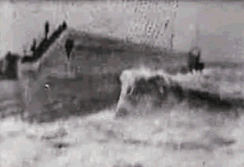
|
1895
BIRT ACRES (1854 - 1918) ROUGH SEA AT DOVER
Sometime between March
and May of 1895 Acres films several more shorts, one of which
he titles 'Rough Sea At Dover' (a portion
of the film - left). Other short films photographed by
Acres were; 'The Derby', 'The Boxing
Kangaroo', 'Comic Shoe Black' and
'Arrest of a Pickpocket' as well as others.
Shortly after the production
of these shorts, Acres parts company with Robert Paul. It
will be almost a year before Acres looks through another lens.
Acres career will sink
into history and obscurity as the career of Robert Paul will
soar.
|
| Three
seconds of the short film 'Rough Sea At Dover' |
'Rough
Sea At Dover' was shown to an invited audience
at Finsbury Technical College, London. |
|
|
| |
|
|
|
| |
The words of a reporter
at the screening . . . "The second film [Rough Sea At Dover]
represented the breaking of waves on the seashore. Wave after wave
came tumbling on the sand, and as they struck, broke into tiny floods
just like the real thing. Some people in the front row seemed to be afraid
they were going to get wet, and looked to see where they could run, in
case the waves came too close." |
|
| |
|
|
|
| |
|
|
| |
|
|
|
| |
|
|
| |
|
1895
THOMAS ALVA EDISON (1847 - 1931)
Early this year Edison
promotes what he calls his Kinetophones.
Edison uses rubber
tubes to connect the viewer of the Kinetoscope
to the Phonograph.
Viewers of the peepshow
can listen to recorded music as they watch the film advance.Although not required,
there is no synchronization. You can find more about music and how music was shaped in those years by
visiting Sound-unsound.
|
|
Edison's Kinetoscope (above)
with Kinetophones in use |
|
|
| |
|
|
|
| |
|
|
| |
|
|
|
| |
1895
CECIL WRAY (1866 - 1944) |
|
|
| |
Wray patents a combination
of lens and prism, which turns the Kinetoscope into a
full-fledged projector. |
|
| |
|
|
|
| |
|
|
|
| |
|
|
| |
|
|
| |
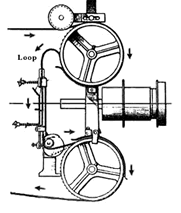 |
1895
MAJOR WOODVILLE LATHAM (1838 - 1911)
A public showing of
a four-minute film takes place in a storefront at 153 Broadway,
New York on May 20 of this year. It was a boxing match which
had been filmed by Woodville Latham and his sons Otway and Grey.
The staged fight had been filmed on the roof of Madison Square
Garden.
The boxers were known
as 'Young Griffo' and 'Battling Barnett'. When asked by son
Otway Latham whether a scene could be projected on a screen
like in the Kinetoscope parlours, father Woodville
answered, "You can project anything
on a screen that you can see with the naked eye and which can
be photographed." |
|
| Diagram
Showing The Latham Loop |
|
Major
Woodville Latham |
|
|
| |
|
|
|
| |
One month earlier to this
event, the Latham men showed off their Eidolscope. The
scenes were of children and one man smoking his pipe. The Eidolscope
was a co-invention between Woodville Latham and William Dickson. Some
commentators however have attributed the Eidolscope to
one Eugene Lauste. |
|
| |
|
|
|
| |
In May
of 1895 The New York World proudly asserted . . . . "Life
size presentations they are and will be, and you won't have to squint
into a little hole to see them. You'll sit comfortably and see fighters
hammering each other, circuses, suicides, hangings, electrocutions,
shipwrecks, scenes on the exchanges, street scenes, horse-races, football
games, almost anything. You'll see people and things as they are."
In June, Woodville Latham applied
for a patent for what he described as a "Projecting
Kinetoscope". Latham's idea in fiming entire boxing
matches instead of one-minute segments required something, which would
allow the celluloid from being torn when passing through the shutter
gate. Latham realized he needed what he referred to as a "supply
of slack". He described this as "feeding
mechanisms located between the devices for supporting the film and separate
and distinct there from, one of said feeding mechanisms being constructed
to uniformly feed the film and produce a predetermined supply of slack."
What ended up being devised was a
'loop' of film that buffers the shutter on each side, whether in a camera
or projector. It became known as the Latham Loop. This
now allowed an entire fight to be filmed on a much longer strip of film.
Whatever the magazine could hold could be shot. The supply reel and
the take-up spool could both be in motion with the only delay being
at the shutter gate during exposure or projection (the intermittent
movement). The diagram above-left shows the loop or 'supply of
slack' prior to entering the gate. |
|
| |
|
|
|
| |
|
|
|
| |
|
|
| |
|
|
|
| |
1895
AUGUSTE (1862 - 1954) LOUIS (1864 - 1948) LUMIERE
One
of the first commercial, public showings of a motion picture
in France (and made with a celluloid film camera/projector),
took place December 28 of 1895 at the Grand Café on the boulevard
des Capucines in Paris. The Lumière's used the basement to
open their movie theatre known as the ‚€˜Cinematographe Lumière
Freres'. A private showing of the machine (as well as experimental
films) took place in March of the same year - see below. The device
was the Cinematographe (below left & right),
and was used in scheduled showings from that point on. It was constructed
by Jules Carpentier of the Lumière factory, with Alfred Molteni
adding the lamphouse, and had a claw-like mechanism in order to
provide the required intermittent pull-down movement of 35mm perforated-celluloid
film. The film which had two perforations per frame, was also manufactured
by the Lumière business. (Image
Source: Smithsonian
Institute) |
| |
|
|
|
|
|
The
Cinematographe (closed) |
'Workers
Leaving The Lumière Factory' |
The
Cinematographe (open) |
| |
|
|
| One
of the rolls of film shown (there were ten) was titled for lack
of a better term, 'Workers Leaving The Lumière Factory'
[Factory La Sortie Des Ouvriers De L’ursine
Lumiere] (above-centre and right). An appropriate name
considering no one had yet made many films, let alone name them.
As the cinema began to become a reality, the people who had worked
feverishly to reach this point were much more concerned with that
of the mechanics than any entertaining aspect. From this point on
however, we now see that fantasy as well as realism becomes the
mind set of the masses and makers, in developing more and more historical
films, horrors, adventures and the like. The development of the
cameras and projectors will continue, but will never again surpass
the need for a never-ending spectacle on the screen, no matter what
the final result. |
|
| The animation
to the right gives an impression of what it may have looked like
for patrons when seeing this film for the first time. 'Workers
Leaving The Lumière Factory' |
|
|
| |
|
|
|
| |
|
|
|
| |
|
|
| |
| THE
LUMIERE EXPERIMENTAL FILMS
The first of the Lumière
private screeings took place on 22 March 1895 in preparation
for the public showing in December of that year. Known as Actualités,
or 'actuality' films, their repertoire of experimental films
amassed to over two thousand by the year 1903.
These films of everyday life
added greatly to the popular culture and by early 1896, the
Lumières
had opened theatres in New York, Brussels, and London, as well
as in France, showing their films on the same machine which
had taken them, the Cinématographe.
One such film was entitled
Arrival Of A Train At La Ciotat Station or,
“L'Arrivée d'un Train en Gare de la Ciotat”
(right). Subtitled and catalogued as number
653, this short featured members of the Lumière
family in the crowd to the right. |
|
| Several
Seconds Of “L'Arrivée d'un Train en Gare
de la Ciotat” (above) from 1895 |
|
|
| |
|
|
| |
Arrival Of
A Train At La Ciotat Station was again shot two years later
in 1897 but did not cause as much of a stir than it did in 1895. Today,
a director wouldn't think twice about angling the camera within feet
of the tracks as a train entered into the frame. We see it all the time.
However, in 1895 it was a frightening thing to see, in a crowded, small
room, with many people and little room to manoeuvre in your seat.
As the train approaches from a distance you realize it is coming awfully
close to you. Using a diagonal frame from (right to left), the Lumières
provided a sense of realism unseen before. It was the phantasmagoria
all over again. Had the Lumières
meant to do this or was it just by accident that their paying customers
thought they were about to be killed? After all, the people walking
along the tracks did not appear to be scared, and they were closer to
the train than the patrons were to the screen.
Consider for a moment how long the steam engine had been in existance.
And how many people had walked alongside the tracks and along platforms
as the trains approached ever so close. Surely this event of seeing
a train become larger and larger wasn't a new experience? Why then the
hysteria in a makeshift movie theatre in 1895? Perhaps it was the unrealism
of it all. How could this real looking train be actually travelling
down the tracks towards us, getting bigger and bigger, closer and closer?
Weren't we after all, sitting in a room nowhere near a train station
and looking at a wall with a white sheet on it?
Yes, and that is exactly why patrons of early films could not understand
or come to terms with the reality of what they were seeing, versus what
they were experiencing. The two did not match. Whether it was a horse
and rider galloping, a train arriving within a few feet of us, or a
cowboy shooting a gun right into our face, the earliest of film-goers
were entertained in a way that has not been seen since, and never will
be again. |
|
| |
|
|
| |
|
|
| |
|
|
|
| |
1895
THOMAS ARMAT (1866 - 1948) |
|
|
| |
Armat came up with the
first projectors in the U.S. that used intermittent movement. In 1896
Armat made a deal with Thomas Edison, for Edison to manufacture them under
the name Vitascope (originally made by Jenkins). |
|
| |
|
|
|
| |
|
|
|
| |
1895
WILLIAM KENNEDY LAURIE DICKSON (1860 - 1935)
Dickson
makes the decision in April to depart the Edison labs for a closer working
relationship with Woodville Latham. |
|
| |
|
|
|
| |
|
|
|
| |
|
|
| |
|
|
| |
| 1896
VICTOR PLANCHON ( - )
Planchon develops for
Louis Lumière what becomes known as the Blue Label emulsion
process (Etiquette bleue) for photographic plates used
by the Lumière lab for manufacturing their celluloid. It
has been suggested that without Planchon, the Lumière's
would have accomplsihed little in the history of cinematography.
Planchon was a chemist from
Paris who took over a government patholgy lab at Boulogne. Planchon's
US Patent states in it's opening lines, "Be
it known that I, Victor Planchon, a citizen of the French Republic,
residing at Lyon, France, have invented certain new and useful
Improvements in Apparatus for the Manufacture of Collodion Filaments,
of which the following is a specification. The present invention
relates to improvements in apparatus for the manufacture of collodion
filaments and the object is, to allow of simultaneously producing
the filament and of coiling it for the purpose of producing regular
cocoons, which allow of carrying out with great facility the final
chemical operation of manufacture." |
|
| |
|
Lumière
Factory (above) c. 1900
|
| |
|
Image
Source: Archives Municipales de Lyon |
Not
only a chemist, Planchon was also an avid student of photography
and it's many processes, particularly gelatine bromide plates.
He later developed a much stronger interest in celluloid. Planchon
was invited to see the Cinematographe in action
and in his own words later submitted,
"I
had the occasion to visit Louis Lumière many times in Paris
, but it was one fine day that I was able to divine, without but
a word exchanged between the two of us, the birth in his marvellous
mind of the general idea of the Cinematograph. Three months after
our first brief glimpse, I sent the first role of film to Lyon.
To our immense surprise... the Cinematograph was born, projecting
life onto a piece of paper set up to act as a screen... and even
then, it had all the perfection of the image that we still admire
today." |
| |
|
|
| Planchon
moved to Lyon and began working full time for the Lumière
laboratories. He created the Société Anonyme des
Pellicules Françaises this year. At it's height, the
factory would provide in excess of 40,000 metres of Cinematograph
Celluloid per working day. In order to produce such quantities,
three other factories were begun in Feyzin. |
| |
|
|
|
|
| |
|
|
|
| |
|
|
| |
|
|
|
| |
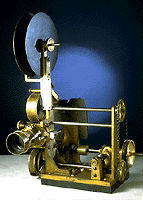 |
1896
THOMAS ALVA EDISON (1847 - 1931)
Edison
perfects and shows his Vitascope projector, which
used the same film as the Kinetoscope. The Vitascope
was the first commercially successful celluloid motion picture
projector in the U.S. The Vitascope was an improved
version of the Phantoscope, an invention of Francis
Jenkins in 1893. Jenkins sold the rights to Edison through Thomas
Armat. Edison presents the Vitascope for the first time in New York
City at the Koster-Bial Music Hall, the present location of Macy‚€™s.
The Vitascope (left)
was originally the Phantoscope by Jenkins. It was
acquired by Edison and changed and presented as the first celluloid
motion picture projector in the U.S. Its commercial debut was in
1896. (Image Source:
Smithsonian Institute) |
| Edison's
Vitascope |
|
|
|
| |
|
|
|
| |
|
|
| |
|
|
|
| |
|
|
|
| |
1896
ROBERT WILLIAM PAUL (1869 - 1943)
A dramatic scenario is shot by Paul and believed to be the first of it's
kind in the UK. Named The Soldier’s Courtship, the lead
actor was Robert Storey. |
|
| |
|
|
|
| |
|
|
|
| |
1896
EDMUD BLOCH ( - ) |
|
|
| |
Patents the Physiographe,
which was a stereo camera, made in the shape of small binoculars. |
|
| |
|
|
|
| |
|
|
|
| |
|
|
| |
|
|
|
| |
1896
RICHARD APPLETON ( 1856 - 1946)
Another daring new filmmaker and camera/projector designer/manufacturer
was Richard Appleton. Appleton also undertook the filming of
Queen Victoria's Jubilee procession in 1897.
Appleton's creation was a three part machine which also acted
as a printer.
The Cieroscope was first seen this year and
Appleton's vision was to film the event and process the film
on the spot in order to show it immediately following the procession.
This is reminiscent of today's cable news broadcasts covering
news almost as it happens, almost 'live'.
Appleton brought in a railway car for his dark room. It was
reported that nearly 250,000 spectators saw the Queens procession
in the days following. |
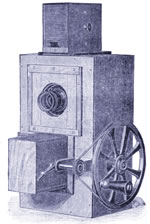
|
|
|
| |
|
Appleton's
Cieroscope of 1896 |
|
| |
|
|
|
| |
|
|
| |
|
|
| |
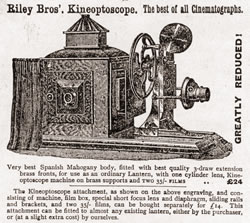
|
1896
CECIL WRAY (1866 - 1944)
Wray's Kineoptoscope
was a projecting device, which attached to a standard
magic lantern. Fitted between lens and housing, the Kineoptoscope
was patented in 1896 and was manufactured for Wray by lantern
makers, the Riley Brothers.
It utilized the lantern's
optics and light source almost as a detachable feed and take-up
reel. It used no sprocket wheels but an intermittent movement
containing a four-pin claw to pull down the film. Wray was an
electrical engineer who began working with magic lanterns and
would also assist in the English version of the Edison Kinetoscope
becoming a projector in 1895.
The Kineoptoscope
was sold by Wray to the Rileys.
|
The Kineoptoscope |
|
|
|
| |
|
|
|
| |
|
|
| |
|
|
| |
|
|
| |
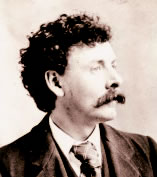 |
1896
GEORGE ALBERT SMITH (1864 - 1959)
Smith uses his magic
lantern background as lanternist to begin producing many short
films on a camera and projector he patented. He experiments
with close ups, double exposures and other trickery. He went
on to create a colour process known as Kinemacolour
but ran into infringement problems when sued by William Friese-Greene.
George Albert Smith |
|
|
| |
|
|
|
| |
|
|
|
| |
|
|
| |
|
|
|
| |
|
|
| |
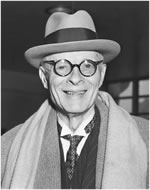 |
1896
CHARLES PATHE (1863 - 1957)
In 1896 Charles Pathé
established the Société Pathé Frères Company
which became one of the biggest film production companies the
industry has seen.
Soon after Pathé
introduced a colour process known as Pathé Color.
Pathé was a
pioneer in the birth of newsreel footage, which in turn became
the forerunner of documentary films. |
|
| Charles
Pathé |
|
The
Famous Pathé Logo |
|
|
| |
|
|
|
| |
|
|
| |
|
|
| |
|
|
|
| |
|
|
| |
| PRIVATE
LANTERN SCREENINGS
Up to and including
1896, private projectionists could be found providing personal
screenings to the upper class and wealthy patrons throughout
the world. These practitioners were traveling lanternists, magicians,
and other cinema showpeople.
However, the popularity
of these private engagements waned following disastrous events
such as the great fire of 1897 at Societe Charite Maternelle
in Paris. Celluloid being highly flammable
and light source safety standards having been put into place,
common public venues became the norm.
Deac Rossell's Living
Pictures provides us a deeper realization of this period
of transition. |
|
| |
An
Evenings Entertainment - The Magic Lantern Show |
|
|
| |
|
|
|
| |
|
|
| |
|
|
| |
|
|
| |
1896
OSKAR MESSTER (1866 - 1943)
At the age of thirty,
Messter introduces what will become known as the Maltese
Cross. Also known as the Geneva Cross,
Messter's mechanism allows for intermittent advancement of the
film in a motion picture projector. This shutter device allows
the frame to be seen clearly before the next frame comes into
place, prevents tearing of the perforated strip and removes
any flicker from the screen.
Messter will experiment
with synchronized sound, and in 1903 present his Biophon
projector synchronized with a Gramophone. |
|
| |
Oskar Messter |
|
|
| |
|
|
|
| |
|
|
|
| |
1896
MAXIMILLIAN SKLADANOWSKY (1863 - 1939)
Skladanowsky and his brother
Emil present commercial motion pictures first in Norway and then throughout
Scandinavia. Their Norwegian venue was the Circus Variété
in Oslo. Their tour lasted approximately months. |
|
| |
|
|
| |
|
|
| |
|
|
| |
| 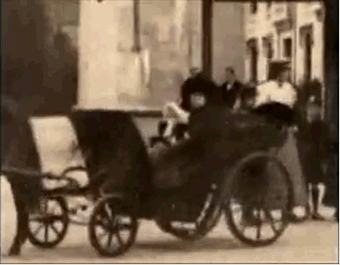
|
1896
QUEEN VICTORIA AT BALMORAL CASTLE
Queen Victoria was born
(1801) before photography was discovered, and began
her reign just two years following the announcement that the
Daguerreotype process was being given freely to the world (1839).
Following
her husband's death in 1861 she became withdrawn and upon counsel
she allowed herself to be photographed not in a way similar
to a royal portrait. She allowed cameras to film her on more
than one ocassion as a way to gain popularity from, and trust
with her subjects. Thus we have perhaps the first use of the
cine camera as a way to broadcast the well being of the Monarchy
to the public.
This
began a long tradition of using the media as an accessibility
tool. This sequence (left) shows the Queen
in a carriage at Balmoral Castle, Scotland on 3 October 1896.
Her daily journal entry for the event reads 'At
twelve went down to below the terrace, near the ballroom, and
we were all photographed by Downey by the new cinematograph
process, which makes moving pictures by winding off a reel of
films. We were walking up and down, and the children jumping
about'.
|
| Footage of Queen Victoria in 1896 at
Balmoral Castle (above) |
|
| |
|
Royal photographers William
and Daniel Downey used specially made 60 mm celluloid that had
four round perforations on each margin. The footage was shown
at Windsor Castle a month later (November). After the gala event,
Queen Victoria wrote 'After tea went
to the Red drawing room, where so-called "animated pictures"
were shown off, including the groups taken in September
[sic] at Balmoral. It is a very wonderful
process, representing people, their movements and actions, as
if they were alive'. The Queen's
royal memory had forgotten that the film was shot in October,
not September.
|
|
|
| |
|
|
| |
|
|
| |
|
|
| |
1896
AUGUSTE BLAISE BARON (1855 - 1938) and FREDERIC BUREAU (d.1896)
Baron and Bureau jointly work
on a sound synchronization system based on the Edison Kinetophone.
Bureau dies this year. |
|
| |
|
|
| |
|
|
| |
|
|
| |
|
|
|
| |
|
|
|
| |
1896
BIRT ACRES (1854 - 1918) |
|
|
| |
Acres presented his Kinetic
Lantern to the Royal Photographic Society in January
this year that received this review in the Journal; |
|
| |
|
|
|
| |
"Mr
Birt Acres gave a demonstration of an apparatus which he called the Kinetic
Lantern. The object of this was to throw a number of pictures upon the
screen in such rapid succession as to reproduce the motion of life. The
photographs for use in the lantern were taken in a somewhat similar apparatus
also devised by Mr. Acres - at the rate of about 40 a second, although
he could if necessary take as many as a hundred in a second, but the effect
of motion was satisfactorily reproduced by projecting them on the screen
at the rate of about fifteen per second. The subjects shown included men
boxing, a review of the German Emperor, Epsom Downs, and the Derby race,
serpentine dancing, and the sea breaking against an embankment".
-
The Photographic Journal, page 123, 31st January 1896 |
|
| |
|
|
|
| |
In 1896 Acres establishes
The Northern Photographic Works company, which will propel him into the
20th century as one of the foremost producers of film stock in England. |
|
| |
|
|
|
| |
|
|
|
| |
|
|
| |
|
|
| |
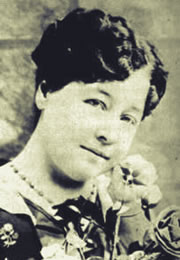 |
1896
ALICE GUY BLACHE (1873 - 1968)
Blache, a French woman,
was the first of her gender to begin experimenting with filmmaking.
She worked as the secretary for Leon Gaumont, a French camera
maker. She is credited with having been involved with the production
of at least 700 films in France and the US.
She later moved to
America and started her own studio, Solax, which was the largest
studio in the US for a short period. Blache began many innovative
techniques never before tried: the use of close ups, reaction
shots and double exposures. She set cars on fire, detonated
explosives, trained rats to attack the lead actors, ran film
backwards, inside out, used animals and made the moon smile.
She later returned
to France and died in obscurity, unremembered.
Alice
Guy Blache |
|
|
| |
|
|
|
| |
|
|
|
| |
|
|
| |
|
|
|
| |
1896
ROBERT WILLIAM PAUL (1869 - 1943)
Paul showcases his Theatrograph
to an audience at Finsbury Technical College, London. Paul made
many short films as well as newsreel footage of the Royal Family,
sporting and political events. For a short time, Paul‚€™s Theatrograph
was the most popular projecting machine in Europe.
In 1896 Paul will meet Ernest
Moy and Percy Bastie and started making supplies for the film
industry. In 1897 and 1898 Moy applied for and was granted patents
for motion picture equipment. They made their first camera in
1900. |
|
| |
Robert
Paul |
|
|
| |
|
|
|
| |
|
|
| |
|
|
|
| |
BIRTH OF
THE MOTION PICTURE THEATRE
Within
about an eight-month window during the year 1895, anyone and everyone
who had tinkered in the business of producing motion pictures,
was now showing them. Even before the Lumiere's, Edison and Acres,
Muybridge had presented his movement of the human form and animal.
Where to show these news pictures of real life? The only buildings
large enough and capable of holding the numbers of people wanting
to see them were the stage and opera houses, music halls and vaudeville
theatres. |
| |
|
|
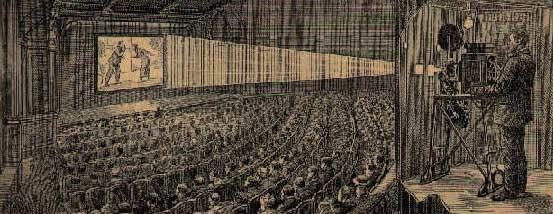 |
Typical of what this new form of entertainment looked like
(left ) is this depiction of a converted Vaudeville
theatre. People flocked to the new 'cinema'
in droves, wanting to see just about anything available. Patrons
were not fussy in these days.
Whether a train robber aiming his gun at the audience and pulling
the trigger with a blast, or a train coming right for the theatre
as if to come through the wall of the building, it did not matter.
|
| An etching of
a ca.1895 vaudeville house converted into a makeshift "movie"
theatre. |
|
|
| |
|
|
| |
|
|
|
The world was just now beginning to experience what would soon
become one of the most exciting and lucrative new industries known
of. As the motion picture projectors were surpassing the nickelodeons
and peepshow machines, group screenings became the norm with audiences
watching 'movies' in town halls, smaller vaudeville houses, arcades,
county fairs, amusement parks, churches, circuses, schools and
in playhouses.
A study of the earliest films
shows us that the scenario, or storytelling had not truly arrived
by 1896. The earliest audiences saw presentations billed by the
name of the projector, not the main actor or title of the story.
Billings such as 'Vitascope Show',
'Evening Biograph Program',
'Panoramic Exhibition', or 'Edison
Moving Picture Show' were typical.
The popularity of this new
form of entertainment became lucrative enough for owners of any
sized indoor establishment to convert a building or room into
makeshift movie theatres. Renovations of these new movie houses
were a simple enough task. A sheet for the screen, some rows of
chairs or benches and some kind of curtain to keep light out from
the front door, and an operator was in business.
The term "box
-office" came from the use of a box that was used
for collecting admission. These simple changes to existing halls
and arcades allowed for an easy take-down should this new entertainment
turn out to be a fad, and not a long-term business venture. |
|
| |
|
An Early Movie
Poster ca. 1896
|
| |
|
|
|
|
| |
|
|
|
| |
|
|
|
|
|
|
| |
1896
AMERICAN MUTOSCOPE & BIOGRAPH COMPANY
Founded
by men like Casler and Dickson, among others, the AMBC (originally
founded as American Mutoscope Company - 'Biograph' being added in
1899) introduces their American Biograph. This
projection apparatus used non-perforated film of a much larger frame
area than was customary at the time, resulting in a much sharper
image. It required very careful handling by the projectionist. Biograph's
first projectionist was cameraman, Billy Bitzer. The American Biograph's
premiere was at New York's Olympia Music Hall on October 12, 1896.
The American Mutoscope and Biograph Company was the spawning ground
of directors D. W. Griffith and Mack Sennett and such stars as Mabel
Normand, Mary Pickford, the Gish sisters, and Florence Lawrence
who went on to become "The Biograph Girl." The
AMBC was dissolved in 1917, but not until joining with Thomas Edison
to form the Motion Picture Patents Company. The AMBC remains the
oldest film company in the US and still in business as a movie production
company. For more on Hermann Casler SEE
CASLER 1890. |
| |
What
could be the first "working" experimental movie [left] made by Edison,
the film seen here is of Hannibal Hause (left) and William
Dickson (right) of the Edison Labs, prior to the formation
of AMBC in 1893. Image Source: Thomas R. Bond II, President, AMBC |
|
|
|
| |
|
|
|
| |
|
|
|
| |
|
|
| |
|
|
|
| |
|
|
|
| |
1896
HERMANN CASLER (1867 - 1939)
Designed and built by
Casler for the newly founded American Mutoscope and
Biograph Company, the Biograph was
unveiled this year in New York. The projector (right)
was formatted for up to 70mm film and was powered by electricity.
Although deeply involved
in the design of the Biograph, Dickson, while
employed by Edison, took no credit when it came time to patent
this projector. Only Casler's name appeared in the papers filed.
The Biograph
used friction rollers which provided continuous movement. No
sprockets where used. The Biograph was in direction
competition with Edison's Kinetoscope and was
of superior quality, a name for which AMBC became synonymous
right up until Casler's death in 1939. |
|
Image
Source: Smithsonian Institute & Hendricks
|
Hermann Casler's
Biograph of 1896 made for the American Mutoscope & Biograph
Company
|
|
|
| |
|
|
|
| |
|
|
|
| |
|
|
| |
|
|
|
| |
1896
ROBERT WILLIAM PAUL (1869 - 1943)
Paul sets up four years worth of screenings at the Alhambra Theatre, Leicester
Square this year. It has taken over eight years for the public to embrace
the commercial aspect of movie going. This now allows producers such as
Paul to secure long runs at these newly renovated 'halls'. Many of Paul's
scenarios are filmed on the roof of this very theatre. |
|
| |
|
|
|
| |
|
|
|
| |
|
|
|
| |
1896
RENE BUNZLI ( - ) AND PIERRE-VICTOR CONTINSOUZA (b. 1872 - ) |
|
| |
Taking one step backward
and two forward, Bunzli and Continsouza suggested the use of a glass-disk-only
device they had patented in France, to replace Celluloid.
Believing that Celluloid was too dangerous for home use,
their machine utilized a glass disk similar to that of previous inventors.
It‚€™s circular shape held photographs taken on it‚€™s surface and placed
in a spiral fashion on the disk. A four-sided Maltese Cross
moved the disk. Their thought of crafting a safe and effective home-based
entertainment system however, was certainly a little ahead of it‚€™s time. |
|
| |
|
|
|
| |
|
|
|
| |
|
|
| |
|
|
|
| |
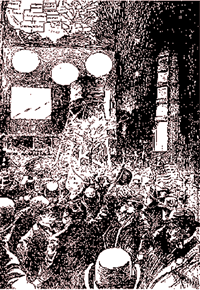 |
1896
U.S. PRESIDENTIAL ELECTION
'HEARST'S MONSTER BULLETIN BOARD'
During the Presidential
elections this year, growing newspaper magnate William Randolph
Hearst employs Stereopticon and Kinetoscope
technology in his attempt to bring the electoral results to
New Yorkers. He drapes the side of his New York Evening Journal
building, (and other locations in the city with erected
wooden towers) with large canvas sheets to act as picture-show
screens.
The screen at the Journal's
building showed a map of the United States at the top with various
other projections of text headlines, images, photographs, panoramas
and "movies"
reported in the paper as the stereopticon-kinetoscope "threw
on cartoons and pictures more or less moving"
as well as "panoramascope pictures".
This was all of course designed
to draw crowds but also to keep the impatient entertained until
the election results could be projected on the canvas.
One of the erected screens
was located at Hammerstein's Olympia Theatre in Manhattan. The
headline read: "the cinegraphoscope,
that new extraordinary combination of electricity and photography,
seemed to make the canvas alive with moving firgures".
|
|
|
| |
From The New York Evening
Journal (above), November 1896 |
|
|
| |
|
|
|
| |
When the time came, these
magic lantern stereopticon projections proclaimed "McKinley
is elected". Electronic headlines and projected images
on the walls of buildings, on giant erected screens and large television
monitors are commonplace today. Times Square in New York is a perfect
example of this technology in the modern age. |
|
| |
|
|
|
| |
|
|
| |
|
|
|
| |
|
|
|
| |
1896
LUMIERE PUBLIC AND PRIVATE SCREENINGS
The Lumière's
continue their private screenings of their Cinematographe
throughout 1896; the Empire Theatre, Lyons, France (private); at the
Empire Theatre of Varieties in Leicester Square, London (private); at
the Marlborough Hall of the Regent Street Polytechnic, London (press
only); at the Regent Street Polytechnic, London (to the paying public).
Continued showings are made to paying audiences in many European countries
by Lumière affiliates.
Regular screenings (including Matinees) begin at various British Halls;
at the Egyptian Hall in Piccadilly; at the Empire Theatre of Varieties
in Leicester Square; at the Olympia; at the Pandora Galley, King's Road,
Brighton; at the Alhambra Theatre and many more. |
|
| |
|
|
|
| |
|
|
|
| |
|
|
|
| |
|
|
|
| |
1897
AMERICAN VITAGRAPH
American Vitagraph
had it's beginnings as 'The International Novelty Company' in
London England as Ronald A. Reader, Stuart Blackton and Albert
Edward Smith (1875-1958)
called themselves while conjuring magic tricks, cartooning,
giving magic lantern shows and entertaining with vaudeville
acts. The men bought and included into their act, an Edison
projector to show films, calling themselves Edison Vitagraph,
deliberately tempting Edison to sue, which he did. Smith then
tore the projector apart re-designing it into the Vitagraph
camera and American Vitagraph was born. In
1905 the company was incorporated as Vitagraph Company
of America and opened a studio in California. The company
was bought by Warner Brothers Pictures in 1925.
|
|
| |
Albert E. Smith |
|
|
| |
|
|
|
| |
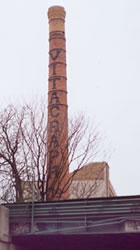 |
The New
York Vitagraph studios were situated in Midwood
Brooklyn on East 15th Street. At the turn of the century it
was known as South Greenfield. Today a smokestack (left)
marking the still-standing location can be seen from Locust
Avenue.
Interior of the Vitagraph
studios (right) showing a dressed set (l),
camera on tripod (r), cameraman (r), several
hanging arc lamps, and a glass roof for daytime shooting.
|
|
| Vitagraph's
Midwood Stack |
|
American
Vitagraph was later changed to Vitagraph Company of America
|
| |
|
|
| |
|
|
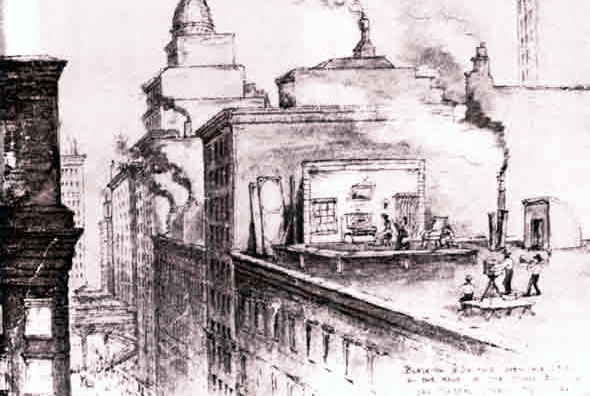 |
Drawing
(left) by Blackton, from Smith's autobiography
'Two Reels and a Crank' published in 1952.
Blackton's
pen gives us a clear idea of what an open-air studio
in the very early days of cinematography, aligned
with ingenuity (using daylight) and a movie
company's budget were all about.
The Vitagraph
location at 140 Nassau Street in the Morse Building
was one of many 'open-air studios' in existence but
one of few rooftop studios. |
|
Smith's
Book 'Two Reels and a Crank' included this drawing by partner
Stuart Blackton of the Vitagraph's Roof Top Studio (above)
|
|
|
| |
|
|
|
| |
|
|
| |
|
|
|
| |
|
|
|
| |
INTERNATIONAL
FILM
A variety of public commercial and non-commercial screenings using a variety
of projectors by a variety of presenter/producers are shown across the
world; Birt Acres at Cardiff Town Hall, Wales; Robert Paul at the Empire
Theatre of Varieties, Johannesburg; at West End Park, Ottawa Canada using
an Edison Vitascope projector; Lubin’s Vitascope, Edison’s
Kinetoscope and Vitascope and Lumière Cinématographe are
used in presentations seen in Japan; at the Zavani Café in Alexandria,
Egypt and other halls and theatres all over the globe. |
|
| |
|
|
|
|
|
|
|
| |
1897
THOMAS ARMAT (1866 - 1948) |
|
|
| |
Armat patents his
'Maltese Cross' action in the projector which now provides a
smooth intermittent movement between frames. |
|
| |
|
|
|
| |
|
|
|
| |
|
|
|
|
|
|
| |
1897
SIEGMUND ( LUBSZYNSKI) LUBIN (1851 - 1923)
Lubin was a German optician
who moved to Philadelphia. He envisioned a great future for
the fledgling movie industry. He is said to be the first to
attempt the mass marketing of the movies. Betwen 1893 and 1895
he had seen Muybridge's Zoopraxiscope and Jenkin's
Phantoscope, and began to construct (along
with the help of C.F. Jenkins) his projector known as the Cineograph.
Having been sued by
Edison on multiple occasions and the United States
government, he was the first to build a chain of movie theatres
and studios.
Lubin later became good friends
with Edison. |
|
| |
Siegmund
Lubin |
|
| |
|
A
photograph from 1899 (below) of a dressed, open-air set
on the roof of the Lubin Studio located at 912 Arch Street in
Philadelphia. The camera is seen in the foreground.
|
|
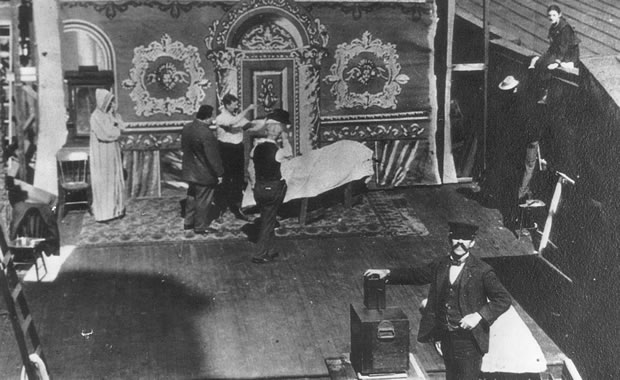 |
Siegmund Lubin manufactured
a Cineograph projector he called a "Marvel".
They were available from 1897 to 1910.
Lubin's Cinegraph camera had been based on the Charles
Pathé studio
camera, except Lubin designed his with a tachometer.
The cameraman could now know the speed at which to crank.
Lubin's first films were made in his backyard - of boxing matches.
|
| See This Large
Format Photograph (1488 x 1174
px) Here |
|
The Lubin
Manufacturing Company saw the potential and
exploitation of this new art of motion pictures and the energy
towards it by people like Thomas Edison. After creating the
Cineograph camera/projector, Lubin wanted to
focus on the production of what was soon becoming known as full-length
feature films.
He opened up his studio in Philadelphia and began producing
commercial films. As the years went by, Lubin would build and
operate one of the largest working movie studios in downtown
Philadelphia, Florida and California.
Lubin may have been the first to 're-make' films that had become
popular. Besides re-makng famous boxing and prizefights, Lubin
also remade such movies as 'The Great Train Robery' and 'Uncle
Tom's Cabin'. He also re-made some of the films of Pathé,
Edison and Georges Méliès.
The Cineograph Projector sold for $150.
|
|
All Images
Courtesy Joseph Eckhardt
|
The Cineograph
In Operation
|
| |
|
|
|
| |
|
|
|
| |
|
|
| |
|
|
|
| |
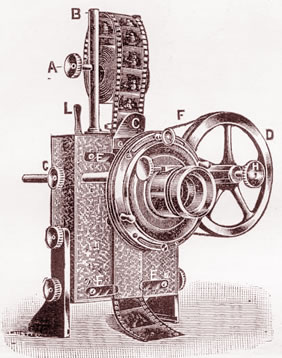 |
1897
CECIL WRAY (1866 - 1944) and CECIL W. BAXTER ( - )
Wray combined forces with
one Cecil William Baxter the year before and went to work designing
and manufacturing a combination camera and projector with him.
They called it the 'B
& W' Cinematograph. They
'perfected' the machine in 1897, calling it just that, the Perfection
Cinematograph.
The Perfection
Cinematograph filmed and projected in 35 mm using a claw
movement to advance the film. Wray and Baxter brought in Joseph
Oulton, a clockmaker, to assist in the precision works. This
machine was vastly different than it's prototype - advertised
as "... will take films of any
length, from 50 feet to 1/2 a mile...". No wonder.
The Perfection Cinematograph (left)
shows no take-up reel!
Besides diving into the technical
side of this new art form, Wray also lectured on a variety of
telecommunications devices including the Kinetograph,
Phonograph and Kinetoscope.
One such lecture demonstrated
the Edison-Bell Phonograph as a replacement for
secretaries and their ability to take shorthand, possibly putting
many out of work!
Baxter and Wray not only sold
their Cinematographs but also sold films to go
with them. How does this remind us of large retailers today who
not only sell DVD and Blu-ray players
but also the DVD's? |
| The
Cecil Wray - Cecil Baxter Cinematograph of 1897 |
|
|
|
| |
|
|
|
| |
|
|
| |
|
|
|
| |
|
|
|
| |
1897
MAXIMILLIAN SKLADANOWSKY (1863 - 1939) |
|
|
| |
The last use of his Bioscop
projector happens this year. Skladanowsky's second generation Bioscop
contained a single band of film. |
|
| |
|
|
|
| |
|
|
|
| |
1897
ROBERT BEARD (1856 - 1932) |
|
|
| |
Beard had
stayed with the times and began taking a serious interest in the new business
of cinematography. This resulted in the Beard Cinematograph.
Beard had seen the Lumière Cinématographe
in action the year before. The Beard Cinematograph had
a Maltese cross intermittent action to move the film forward. |
|
| |
|
|
|
| |
|
|
| |
|
|
|
| |
| 1897
FILMING OF QUEEN VICTORIA'S DIAMOND JUBILEE
Before newsreels developed
out of story telling cinematography, enthusiasts of this new
art form took it upon themselves to film great events of the
age.
Instead of shooting people
crossing a bridge, dancing in a yard or trains arriving, we
begin to see actual news-worthy events being filmed and shown
the next day, or sometimes within hours.
This footage (right)
is of Queen Victoria's Diamond Jubilee procession, which took
place on Pall Mall, Westminster, London on June 22, 1897.
The Queen had actually surpassed
all reigning English and Scottish monarchs on 25 September 1896
but waited until the summer of 1897 for the celebration to align
with her Diamond Jubillee.
|
|
Several Seconds of
Queen Victoria's Diamond Jubilee Procession (above right)
From 1897. It cannot be proven emphatically from whose's camera
this film originated from.
|
| |
|
| Many
if not all British cinematographers were present along the procession
including Robert Paul, Alfred Wrench, Birt Acres, John A. Prestwich
and R.J. Appleton. A respectable amount of film from this event
survives from these pioneers. |
|
|
| |
|
|
|
| |
|
|
| |
|
|
|
| |
1897
INSTANT REPLAY
When
French President Félix Faure is accused of not raising his hat
to the Russian flag on an official state visit to St Petersburg, a film
taken by the court photographer is viewed. It shows clearly that the President
did in fact raise his hat in respect of Tsar Nicolas II. |
|
| |
|
|
|
| |
|
|
|
| |
|
|
|
| |
1897
CHARLES PATHE (1863 - 1957) |
|
|
| |
Pathé instituted
the Pathé Journal, his trademark newsreel series
and later, Pathé News. He went on to film un-staged
scenes and events and produced a hand-coloured stencil application, Pathé
Color. The company was purchased in 1956 by Jack Warner. |
|
| |
|
|
|
| |
|
|
|
| |
|
|
| |
|
|
|
| |
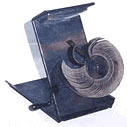 |
1897
AUGUSTE (1862 - 1954)
LOUIS (1864 - 1948) LUMIERE
The
Kinora was an animated peepshow device appearing
this year. The device contained three lenses so that three could
view at a time. It operated through a clockwork motor wound to it‚€™s
fullest prior to viewing. A mirror at the top of the Kinora
allowed ample light for viewing. Primarily made of wood, the machine
is heavily weighted to avoid tipping. The Kinora
shown here (left) is circa 1910 and is also known as a
Flicker Reel Picture Viewer. The name came from
the fact that film negatives from early films were used to produce
the images. Others also made the Kinora, namely, Kinora Ltd., of
England. This model (left) contains a single lens.
(Image Source:
Lionel
Hughes Photographica) |
|
|
| |
|
|
|
| |
|
|
| |
|
|
|
| |
1897
AMERICAN MUTOSCOPE & BIOGRAPH
COMPANY
AMBC builds
a film studio with removable glass walls. It can be slanted towards the
sun for maximum light and has the capability of a rocking motion for special
effects. The studio is built in London. |
|
| |
|
|
|
| |
|
|
| |
|
|
|
| |
1898
ALFRED WRENCH ( - ) |
|
|
| |
| By
this year Wrench had patented what he called his Cinematograph
which was a projector as well as a camera. He
filmed Queen Victoria's Diamond Jubilee procession the year before,
using this camera.
It mimicked the Cinématographe
in construction and was based on a rachet and pawl mechanism.
The film shot was over 800 feet contained on 7 reels.
A later version of this
camera had a movement with two triple-pin pulldown arms.
The Wrench Cinematograph
projector shown here (right) from 1898 also showed lantern
slides. It became the projector of the Empire Theatre at Leicester
Square in 1897 replacing the Lumière device of the same
name.
|
|
| |
Alfred Wrench's Cinematographe of 1898 (above) |
|
|
| |
|
|
|
| |
|
|
| |
|
|
|
| |
1898
OSKAR MESSTER (1866 - 1943)
Oskar Messter films what could be the first medical operation for use
in teaching. The film is shot at the Surgical Centre at the University
of Berlin for use at Kiel University. |
|
| |
|
|
|
| |
|
|
|
| |
1898
HANNIBAL GOODWIN (1822 - 1900) |
|
|
| |
Goodwin finally is granted
a patent for his Cellulose roll film, eleven years after
application. Eastman had already started manufacturing a roll film in
1889. The resultant patent infringement suit resulted with a judgment
against George Eastman, and a $5 Million award to Goodwin in 1914. |
|
| |
|
|
|
| |
|
|
| |
|
|
| |
|
|
|
| |
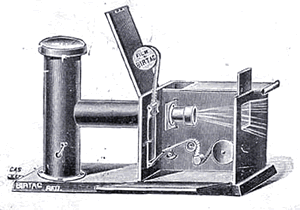 |
1898
BIRT ACRES (1854 - 1918)
Hoping to coin the phrase
'home movies' Acres begins production of his Birtac
amateur cine camera/projector. He markets it in England as a
competitor to the now established Kodak products.
The Birtac did not fair well however, with
less-expensive quality products. This machine ran 17.5mm film
and was known as the Birtac Home Cinema.
The manual and packagng boldly stated it was . . . "to
place animated photography within the reach of everyone".
|
|
The
Birtac Projector |
|
The
Birtac Camera |
| |
|
|
|
|
| |
|
|
| |
|
|
|
| |
|
|
| |
1898
LEONARD ULRICH KAMM (1861 -?)
Kamm designed and built
the Kammatograph (right) which was capable
of holding in excess of 500 minuscule photos all around the
edge of a 12 inch diameter disk.
The exposures were placed
in a spiral fashion around the disk. The Kammatograph
was a combination camera and projector.
Even this was nothing compared
to what Celluloid was now doing to the art
of cinematography. |
|
| |
Leonard
Kamm's Kammatograph (above) 1898 |
|
|
| |
|
|
|
| |
|
|
| |
|
|
| |
|
|
|
| |
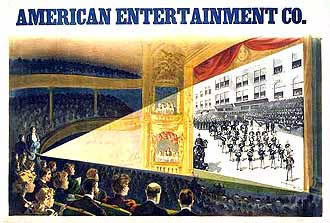 |
MOVING PICTURE
POPULARITY
This
lithograph by the Donaldson Lithographic Company of Cincinnati c.1898,
is typical of how early films were portrayed at least from an advertising
perspective. It was not uncommon for the filmmakers to allow a space
at the top of the posters for the film exhibitor to advertise their
name, in this case, the American Entertainment Company.
This particular poster depicts a film scene of troops in formation.
Not something we would pay to see today but something early patrons
lined up for. It was the draw of the technology, not the subject
matter that first shook the world. (Image
Source: Library
of Congress) |
| |
| Notice
the projectionist is centered within the audience and on the first
balcony. Although this may be the artist's attempt to ensure the
technology is showcased, makeshift theatres in the early days of
movies did not have a natural place to put the projector and it's
operator. Many halls and Vaudeville venues had to 'compromise'. |
|
|
| |
|
|
| |
|
|
|
| |
|
|
|
| |
1898
HENRY WILLIAM SHORT ( - )
The
Filoscope was patented by Short which resembled
and mimicked the Mutoscope of Casler. Photographs
depicting successive motion were loaded one after the other in a
holder which was inserted in the device. A slide lever when turned
flipped the photos imitating motion. The Filoscope
actually contained little books where cinematic prints from photographs
were bound one on top of the other. Once inserted in the Filoscope,
and turned by hand, a series of motion pictures appeared to the
viewer. Short was a camerman for Robert W. Paul. |
|
|
The
Filoscope By Henry Short |
|
|
| |
|
|
|
| |
|
|
| |
|
|
|
| |
1898
JOHN ALFRED PRESTWICH (1874 - 1952)
Manufactured by the
Prestwich Manufacturing Company in London, England, in 1898
and designed by Prestwich himself, this camera known as the
Model "4" originally had external
magazines with 400 foot capabilities.
In his improved model Prestwich
placed all spools inside for good reason. Light entering could
not be allowed, especially when the first take was crucial.
Pathé
at the time still manufactured cameras with external magazines.
The Australian cinematographer
Frank Hurley when he went on the Shackleton Antarctic Expedition
used a Prestwich as his camera.
|
|
|
|
| |
The
Model "4" camera of Prestwich (above right). Image
Source: The Internet Encyclopedia Of Cinematographers. |
|
| |
|
|
| |
|
|
|
| |
1898
CARL ZEISS (1816 - 1888)
Zeiss works on an anamorphic lens to be used in motion picture cameras.
An anamorphic lens is used on a camera to distort the image being filmed
by optically compressing the image so that it will fit into a 35mm film
frame. During projection the projector is then fitted with another anamorphic
lens which then reverses the distortion. The 35mm film is projected the
way it was filmed, in its widescreen format. |
|
| |
|
|
|
| |
|
|
|
| |
1899
WILLIAM EDWARD FRIESE-GREENE (1855 - 1921) |
|
|
| |
Friese-Greene develops
a camera/projector utilizing a Celluloid band with a
perforated strip along the edge. In 1888 Friese-Greene used a cinematographic
camera to film a short piece at 5 frames per second but without a perforated
edge. Over a thirty-two year period, Friese-Greene took out seventy-eight
patents, none of which applied to any outstanding invention. |
|
| |
|
|
|
| |
|
|
|
| |
|
|
| |
|
|
|
| |
FRENCH
LANTERN POSTCARD
A
French Lantern Postcard of the late 19th century
(below). This working mechanical Chromatrope had
a revolving disc which could be turned by the receiver using their
fingers. The upper and lower sections of the card reveal the inserted
wheel, held by a centre-piece between the front (below-left)
and back (below-right). Commercially produced using cardboard,
this postcard was made by a firm manufacturing margarine.
(Courtesy the Thomas
Weynants Collection). To
learn more of virtual reality techniques during the French Revolution
and the early 19th century by Thomas, and his discovery of a Fantascope
lantern in the French castle Ch√Ęteau de Moisse,
SEE MOISSE or visit the
Dead Media website. |
| |
|
| |
|
| Revolving
the exposed disk with the finger tip would animate the
"projected image" from the lantern on the table. |
The
popular culture had embraced the lantern and all things optical.
This Chromatrope postcard is one example of it's popularity. |
|
|
| |
|
|
|
| |
|
|
| |
|
|
|
| |
|
|
|
| |
1899
GEORGE EASTMAN (1854 - 1932) |
|
|
| |
Eastman introduces the
first Panoramic Camera. The camera takes pictures 3.5
by 12 inches, on Eastman‚€™s roll film. Eastman also incorporates the Kodak
camera name, into the company name (Eastman Kodak). Regarding
his early cameras and pre-loaded film, Eastman was known for saying .
. . "You push the button, we do the rest".
One of the catchiest marketing lines of all time. Eastman took his own
life as a result of a progressive nervous disorder he had which haunted
him his whole life. |
|
| |
|
|
|
| |
|
|
|
| |
1899
EDWARD RAYMOND TURNER ( - 1903)
Turner produces a protoytype motion picture tri-colour system capable
of producing blue, red and green colour photographs. The system required
48 fps and resulted in being the first system to attempt motion photography
in natural colours. Although primitive, the 'additive principle' used
a rotating wheel with red, blue and green sections positioned on the camera
and a rotating filter wheel as well, on a three-lens projector. This system
and concept passed through different hands over the years such as Charles
Urban and Alfred Darling and was somewhat indirectly responsible for a
system known as Kinemacolor which surfaced in 1906 as
the first 'successful' motion picture system producing natural colours. |
|
| |
|
|
|
| |
|
|
|
| |
|
|
| |
|
|
|
| |
1899
AMERICAN MUTOSCOPE & BIOGRAPH COMPANY - THE JEFFRIES/SHARKEY
FIGHT |
| No
better example of the popularity of cinema in the late 19th and
early 20th centuries as a tool to promote and sell, is the heavyweight
title prizefight between Jim Jeffries and Tom Sharkey. Boxing
matches had long been filmed by now, but nothing on this scale
had been seen by the live eye, let alone on the screen. The fight
took place on the evening of November 3rd, and The American
Mutoscope and Biograph Company had been chosen by promoter
William Brady to film the event for the world. Long gone were
the days of watching people leaving work. Cinematography
and sports would never be the same again. |
| |
|
|
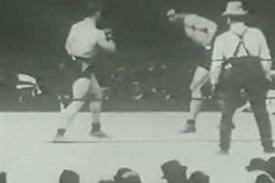 |
This picture(left) of the Sharkey-Jeffries fight was
taken on the evening of November 3, 1899 at Coney Island, New
York. The fight went twenty-five rounds, and required 500 arc
lamps to light the event for filming.
The Biograph film used was 2.75 inches wide
with the frames 2.25 inches high. Each minute required 320 feet
of film at the rate of 30 frames per second. In comparison,
the animation below is 3.75 inches high by 2.75 inches wide.
Both fighters complained the arc lamps
made it too hot. They vowed never to fight under these terms
again. Within a week, the fighters had agreed to, and filmed
the final round for the cameras due to the fact Biograph had
run out of film.
|
| This
still photograph (above) is of the Jeffries-Sharkey
title fight of 1899. |
|
|
| |
|
|
NOVEMBER
3, 1899
Biograph
operated four cameramen to film the event. One camera
was designated to shoot the action, one remained loaded
and ready for when camera one signalled he had run
out of film. A third camera in the rotation was reloading
while a forth was for backup in case one of the three
failed.
Two hundred
thousand frames were photographed that night, none
of which is believed to exist. Perforations along
the film were made within the Biograph
camera, and buckling of the film happened throughout
the fight. Cameramen were able to monitor this technicality
by watching the film via a red-glass peephole on the
side of the camera wall. To further ensure no light
destroyed the exposure, and that the cameraman could
see the celluloid passing, a small red light bulb
was inside the camera to provide some illumination.
|
|
|
| Seven
seconds of footage (above) taken by the Vitagraph camera. |
| |
|
|
| Even though
no stock remains from the seven miles of film that was taken
that night by AM&BC, there is approximately
five minutes of known footage. The footage above-right is from
what has been described as bootleg footage from that night,
taken possibly by a fan with a hidden camera within the crowd.
This however, is unlikely for a number of reasons, two of which
are the high security of the event surrounding filming rights,
and the fact that cameras in 1899 weren't exactly something
a person could hide under a jacket or in a cigar box, let alone
set up and operate amongst a crowd of fight fans.
If it can be said, in those days Biograph
had the 'rights' to filming the fight. However in the early
days of movies, there was ruthlessness in the business. Vitagraph
had secretly stationed their camera further back, behind the
Biograph employees and cameras. A second fight
broke out, this one outside the ring, after Biograph
had discovered the camera. Even though Vitagraph
did manage to photograph the fight, Thomas Edison's long arm
reached out and removed the film from the Vitagraph
lab on the evening they had processed the film.
Jeffries won the contest, but both fighters agreed to re-film
the final round due to the fact AM&BC ran
out of film. In the years to follow, Jeffries toured the U.S.
giving theatrical performances in a play called "The Man
from the West." The Jeffries-Sharkey fight was the first
ever filmed under artificial lighting. |
|
|
|
|
|
| |
|
|
| |
|
|
|
| |
|
|
|
| |
1999
CECIL M. HEPWORTH (1874-1953)
Hepworth
builds a working film studio in the backyard of a house in Walton-on-Thames
and names it Hepwix. Of all the pioneer filmakers if Britain, Hepworth
lasted longer than any. His sense of story telling and taste for strange
scenarios was an unusual mix of the Lumière's shoot-everyday-life
thinking, and that of Edwin Porter's in-your-face style. Some of Hepworth's
titles included 'Explosion Of A Motor Car' (1900), 'How It
Feels To Be Run Over' (1900), and 'Baby's Toilet' (1905).
He even filmed Carroll's 'Alice In Wonderland' (1903) for the
first time. He was the son of lantern showman T.C. Hepworth. |
|
| |
|
|
|
| |
|
|
|
| |
1900
CHARLES-EMILE REYNAUD (1844 - 1918) |
|
|
| |
With the coming of pure
cinematography and the fact he was penniless, Reynaud destroyed the only
Praxinoscopes (3) he had and threw all except two of
his films into the river Seine. He closed the Th√©√Ętre Optique
and Reynaud's son Paul Reynaud salvaged 17 frames of one film which resides
at the National Museum of Prague. |
|
| |
|
|
|
| |
|
|
|
| |
|
|
| |
|
|
|
| |
1900
ERNEST FRANCIS MOY ( - ) and PERCY HENRY BASTIE ( - )
Moy and Bastie started
a company in England in 1895 manufacturing circuit breakers.
In 1896 they had met Robert Paul and were making items for the
film industry. They made their first camera in 1900, with 400
foot external magazines, placed on the top of the camera (not
shown).
The Moy
and Bastie camera of 1900 (right). Image Source: the
Internet Encyclopedia of Cinematographers.
|
|
|
|
| |
|
|
|
| |
|
|
| |
|
|
|
| |
|
|
| |
1900
LUMIERE AND SONS / THE
PHOTORAMA
At the Paris International
Exhibition of 1900, the Lumière's (Auguste and Louis)
presented their Photorama Lumière, a
360 degree panoramic projector which used 70mm
film and an analyphic stereoscopic motion picture system which
was later introduced in 1935.
The Lumière
Photorama was a process for wide screen static
projection. The screen was between 20 and 21 metres in circumference
and six metres high. The system used revolving lenses (image
below) to project that of landscapes, riverscapes and cityscapes.
Even though static, the Photorama depended
upon persistence of vision as is the case with Cinematography. |
|
| |
|
Cross Section
Showing the Photorama's Size and Operation
|
| |
|
Image Source:
Institut Lumière Collection
|
| |
|
|
The
Photorama of the Lumière's, expanded on
the Panorama of Barker, but by projection as
opposed to paintings. The system consisted of 12 lenses fixed
on a circular plate which turned in a graduated fashion, three
times each second. These fixed lenses turning in unison allowed
for the film-frames to also remain fixed. By allowing the lenses
to sweep past the film in a circular motion, this allowed each
frame to be seen in a separate but constant, state. The Photorama
was a projection of photographs that encircled the audience.
|
| |
|
|
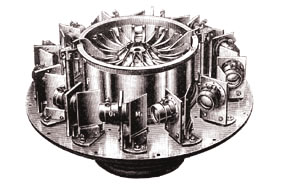 |
The
patent for the Photorama was granted in 1902 for "a
method for producing a static circular photograph".
The patent for "a system of stereoscopic
cinema" was granted on December 29, 1900. The
Lumière's
were also pioneers of colour photography. They invented the
first commercially successful method of creating a colour photograph
on a single plate. It was known as the Autochrome
process and was patented in 1907.
By 1915 cinematography had spread like wildfire
and had roots in all industrialized nations of the world. The
Lumière's
however were not a part of it. Except for their experimental
films lasting upwards of a minute, the Lumière's
were never a part of the boom which was already appearing, even
in France. Almost as a self-fulfilling prophecy, Louis Lumière
stated, "the cinema is an invention
without a future." |
| The Lumière's
Twelve Lens System of the Photorama |
The
Institut Lumière
houses over 1,500 Lumière
films in it's archives. |
| Image
Source: Institut Lumière Collection |
|
|
|
|
| |
|
|
|
| |
|
|
|
| |
|
|
| |
|
|
|
| |
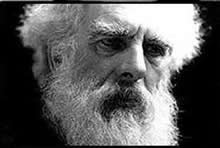 |
1900
EADWEARD JAMES MUYBRIDGE (1830 - 1904)
Having
returned to his native England, Muybridge bequeathed to the Kingston-on-Thames
public library, his Zoopraxiscope, some lantern slides, some plates
from his University of Pennsylvania days, and some cash.
E.
J. Muybridge 1830-1904 |
|
|
| |
|
|
|
| |
|
|
| |
|
|
|
| |
|
|
|
| |
|
|
| |
|
|
|
| |
|
|
|
| |
|
|
|
| |
|
|
|
| |
|
|
|

|
| |

